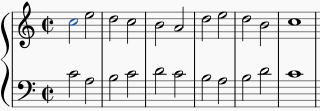 The Blogging A-to-Z challenge now takes you back about 1,100 years to the beginnings of Western music: Gregorian chant.
The Blogging A-to-Z challenge now takes you back about 1,100 years to the beginnings of Western music: Gregorian chant.
Simple plainchants go back before people generally wrote music down. In the late 9th and early 10th centuries—around the time of Pope Gregory I—we start to find some of the earliest written examples of simple monophonic chants.
Some remained part of general liturgical music well into the 18th and 19th centuries, like this example:

Here it begins a performance of the second movement of Mozart's "Great" Mass in c-minor in 2011:
If you have studied music theory, you have written your own ersatz plainchants, because the unit immediately following would introduce you to counterpoint. On Friday I discussed the ultimate expression of counterpoint, the fugue; today I'm going to back up a ways and just show how two lines of music can work together.
The simplest variety, first-species counterpoint, takes a chant (called a cantus firmus, literally a "solid song") and adds another line above or below that begins and ends in perfect consonance. Here's a cantus firmus:

To create a first-species counterpoint, I just need to follow a couple of rules, and voilà:

What does this have to do with Gregorian chant? Well, going from chant to polyphony happened something like that. For centuries the Catholic Church forbade polyphony. Then someone passed the pope a perfect fifth at a party, and he tried it a little, and pretty soon churches all over Christendom had this kind of counterpoint going on. It wasn't quite as simple or formal as music theory pedagogy would suggest, but it did lead ultimately to the polyphonic music we know today.
Come back tomorrow to learn what happens when you add a third voice to a composition.